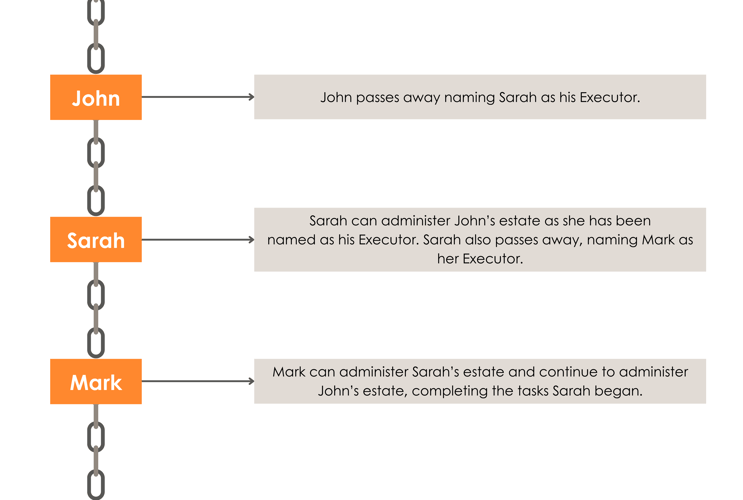A chain of representation is the legal structure that ensures the ongoing management of an estate following an individual's death. When someone is appointed as an Executor under a Grant of Probate (if the deceased had a valid Will), or as an Administrator under a Grant of Letters of Administration (if there was no valid Will), they act as the representative of the deceased's estate. This formal representation is granted by the Probate Registry.
An example of a chain of representation
Let's look at an example to better understand the chain of representation. John creates a Will naming Sarah as his Executor. After John's passing, Sarah takes on the role of Executor and obtains a Grant of Probate in her name to begin administering John's estate.
However, before Sarah can finish administering John’s estate, she also sadly passes away. In her own Will, Sarah has appointed Mark as her Executor. Mark steps in to manage Sarah’s estate and, according to the chain of representation, he is also able to serve as the Executor for John’s estate, continuing the administration for both estates.
In practice, this means that Mark can carry out the tasks Sarah began and can continue to administer John's estate according to the instructions in his Will. To demonstrate the chain of representation and manage both estates, Mark would need to present both the Grant of Probate issued in Sarah’s name and the Grant of Probate issued in his own name.
The chain of representation can continue in this pattern for as long as is necessary to either complete the estate administration or break the chain. For example, if Mark were to pass away before completing the administration of both estates (and left a Will), his designated Executor would take over the responsibility of managing all three estates.
This example illustrates how the chain of representation ensures a smooth transition of executorship, allowing the administration of multiple estates to proceed without disruption, in accordance with the terms of the respective Wills.

What does breaking the chain of representation mean?
Breaking the chain of representation means that the legal continuity of the administration of an estate has been interrupted. Essentially, the chain of representation is "broken" when there is a gap in the line of appointed individuals who are responsible for managing the estate. If a proposed Executor or Administrator dies intestate, meaning they did not leave a valid Will, it breaks the chain of representation.
A chain of representation can also be broken if an Executor fails to obtain a Grant of Probate in their name before they pass away. For instance, in the example above, if Mark began managing Sarah’s estate but died before receiving the Grant of Probate for her estate (in his name), the chain of representation would be interrupted.
When the chain of representation is broken, the administration of the original estate passes to the next of kin, following the rules of intestacy.
Is it possible fix a broken chain of representation?
Yes, it is possible to fix a broken chain of representation. To resolve this issue and regain the legal authority to manage the original estate, the next of kin would need to repeat the estate administration process. They would need to apply for a Grant De Bonis Non, which is a legal document issued by the court that allows a person to step in and continue the administration of an estate when the original Executor or Administrator is unable to complete the task.
A Grant De Bonis Non may be needed if the original Executor or Administrator has died, renounced their role, or is otherwise unable to carry out their duties. This could be due to personal reasons, time constraints, or being mentally or physically incapable of the task. The individual granted this authority is typically referred to as an "Executor De Bonis Non" or "Administrator De Bonis Non” (depending on whether the deceased had a valid Will or not).
This document serves as the title for the new Administrator and specifically authorises them to manage the remaining assets or unfinished business of the estate, essentially continuing the original probate process.
How to apply for the Grant De Bonis Non (with Will Annexed)
The Grant De Bonis Non is requested through the Probate Registry using Form Cap A5C. However, the Probate Registry outlines only three specific situations in which a Grant De Bonis Non is required:
-
On the death of the sole or last surviving Administrator where part of the estate is still unadministered.
-
On the death of the sole or last surviving Executor where the chain of representation is broken, and part of the estate remains unadministered.
-
Where the sole or last surviving Executor or Administrator becomes mentally incapable.
Ensuring that at least one of these situations has been met before applying for the Grant De Bonis Non is crucial to be successful. The process is similar to applying for a Grant of Probate, but with some specific steps. Here’s how to apply:
-
Determine the eligibility of the applicant.
-
Gather required documents such as the original Will and death certificate.
-
Complete the application forms (the specific forms may vary depending on the jurisdiction).
-
Pay the relevant fees (there may be a fee associated with the application, dependent on the jurisdiction and value of the estate).
-
Submit the completed application, along with all required documents, to the Probate Registry. Depending on the jurisdiction, you can submit an application online or in person).
GOV.UK currently states that Grant applications are taking approximately twelve weeks to complete, and the Grant De Bonis Non may take longer depending on the level of case complexity, errors when submitting documents, and more.
Why is it important to have a valid Will as an Executor?
If individuals are aware that they are appointed as an Executor, it is even more crucial for them to ensure that they themselves have a valid Will in place. Failing to do so can lead to complications, such as involving other family members who would need to apply for the Grant De Bonis Non, which can prolong the estate administration process.
Another important complication to consider are contentious matters, this is because without a clear and legally binding document outlining the deceased person's wishes, there can be uncertainty and disputes among family members and other beneficiaries, regarding the distribution of assets and possessions. This makes it crucial for individuals to have a properly executed and valid Will to maintain the integrity of the chain of representation and reduce the potential for contention. To learn more about the purpose and importance of a Will, read our blog.
If you need help with probate, administering an estate, or understanding Trusts, contact us by filling in the form below or call our Client Services Team on 0300 303 9000.






